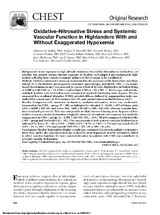Mostrar el registro sencillo del ítem
Oxidative-nitrosative stress and systemic vascular function in highlanders with and without exaggerated hypoxemia
| dc.contributor.author | Bailey, Damian M | |
| dc.contributor.author | Rimoldi, Stefano F | |
| dc.contributor.author | Rexhay, Emrush | |
| dc.contributor.author | Pratali, Lorenza | |
| dc.contributor.author | Salinas Salmón, Carlos | |
| dc.contributor.author | Villena, Mercedes | |
| dc.contributor.author | McEneny, Jane | |
| dc.contributor.author | Young, Ian S | |
| dc.contributor.author | Nicod, Pascal | |
| dc.contributor.author | Allemann, Yves | |
| dc.contributor.author | Scherrer, Urs | |
| dc.contributor.author | Sartori, Claudio | |
| dc.date.accessioned | 2016-09-23T16:11:35Z | |
| dc.date.available | 2016-09-23T16:11:35Z | |
| dc.date.issued | 2013-02-01 | |
| dc.identifier.uri | http://repositorio.umsa.bo/xmlui/handle/123456789/8012 | |
| dc.description.abstract | Background: Acute exposure to high altitude stimulates free radical formation in lowlanders, yet whether this persists during chronic exposure in healthy, well-adapted and maladapted highlanders suffering from chronic mountain sickness (CMS) remains to be established. Methods: Oxidative-nitrosative stress (as determined by the presence of the biomarkers ascorbate radical [A•-], via electron paramagnetic resonance spectroscopy, and nitrite [NO22], via ozonebased chemiluminescence) was assessed in venous blood of 25 male highlanders in Bolivia living at 3,600 m with CMS (n513, CMS1) and without CMS (n512, CMS2). Twelve age- and activitymatched, healthy, male lowlanders were examined at sea level and during acute hypoxia. We also measured flow-mediated dilatation (FMD), arterial stiffness defined by augmentation index normalized for a heart rate of 75 beats/min (AIx-75), and carotid intima-media thickness (IMT). Results: Compared with normoxic lowlanders, oxidative-nitrosative stress was moderately increased in the CMS2 group (P,.05), as indicated by elevated A•- (3,191 457 arbitrary units [AU] vs 2,640 445 AU) and lower NO22 (206 55 nM vs 420 128 nM), whereas vascular function remained preserved. This was comparable to that observed during acute hypoxia in lowlanders in whom vascular dysfunction is typically observed. In contrast, this response was markedly exaggerated in CMS1 group (A•-, 3,765 429 AU; NO22, 148 50 nM) compared with both the CMS2 group and lowlanders (P,.05). This was associated with systemic vascular dysfunction as indicated by lower (P , .05 vs CMS2) FMD (4.2% 0.7% vs 7.6% 1.7%) and increased AIx-75 (23% 8% vs 12% 7%) and carotid IMT (714 127 mM vs 588 94 mM). Conclusions: Healthy highlanders display a moderate, sustained elevation in oxidative-nitrosative stress that, unlike the equivalent increase evoked by acute hypoxia in healthy lowlanders, failed to affect vascular function. Its more marked elevation in patients with CMS may contribute to systemic vascular dysfunction. | es_ES |
| dc.language.iso | en | es_ES |
| dc.publisher | CHEST | es_ES |
| dc.subject | HYPOXEMIA | es_ES |
| dc.subject | ALTURA | es_ES |
| dc.subject | DISFUNCIÓN VASCULAR | es_ES |
| dc.title | Oxidative-nitrosative stress and systemic vascular function in highlanders with and without exaggerated hypoxemia | es_ES |
| dc.type | Article | es_ES |

